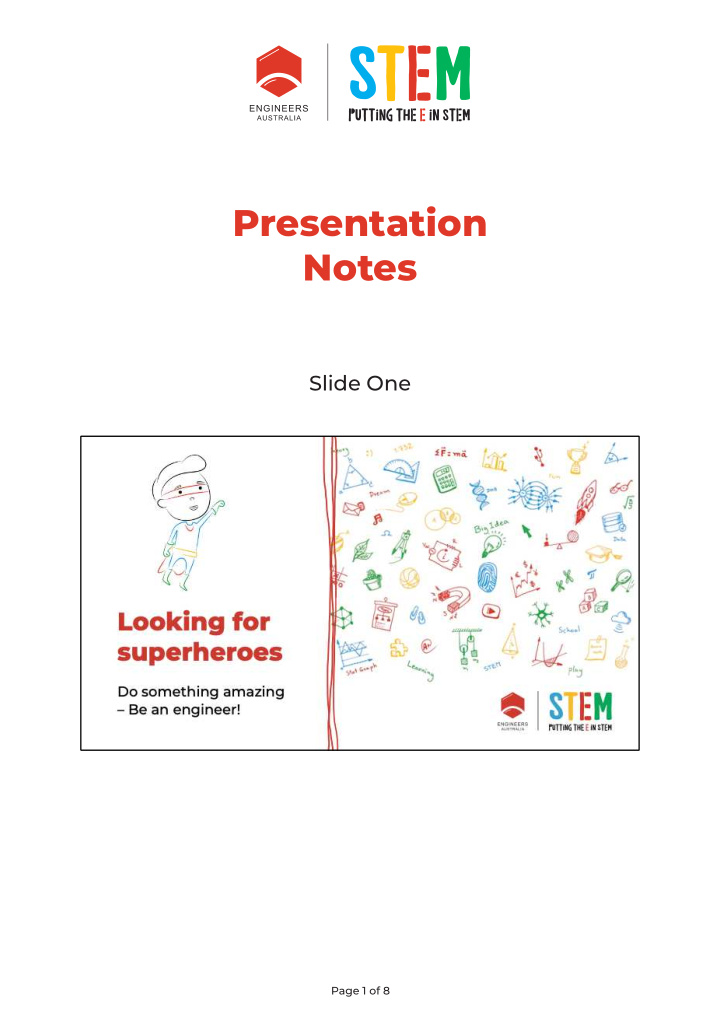



Presentation Notes Slide One Page 1 of 8 1
Slide Two Your aim: inspire kids about the big-picture of why engineering matters, and how engineers shape the future...without using the word ‘engineering’ in this slide. Would you like to do something amazing? You can. You could be a: • Planet cleaner (make our world cleaner) • Star maker (the person who helps someone become famous - or maybe you will be the famous person yourself) • Robot ruler (making robots that do whatever you say) • Real-life creator (the one who turns amazing Lego and Minecraft creations into real things) • Time traveller (well, this hasn’t happened yet, but you might be the one!) So how do you get to be any of these? Maybe you want to be all of these? Start with enjoying your classes, which teach you how things work and how to make things by solving problems. 2 Page 2 of 8
Slide Three Your aim: illustrate how engineering touches modern-day life. (Depending on your available time and your interests, you could choose one or more of these to talk about.) Did you know that engineering is everywhere? From the games you play to the smells you sniff - engineers help to change the world. Hands up - Who likes to play with Lego? (Intro) You can take playing with Lego all the way through to building robots that help make our food. <video Robot maker> 0:40 Hands up - Who likes to watch TV? (Intro) When you’re sitting down at home watching TV, there’s a whole team of people working to make sure nothing breaks down. <video BBC TV engineer> 0:40 Hands up - Who likes good smells? What about bad smells? (Intro) There’s someone who has to be in charge of finding new fragrances for products we buy. Do you think this lady has a fun job? 3 <video Fragrance Finder> 0:40 If you investigate and find out how we get to enjoy these things, you’ll see that people called engineers used their superhero engineering skills to solve the problems they found. Page 3 of 8 3
Slide Four Your aim: connect engineering disciplines with real-life problems that could shape the future. Can you imagine how to grow gold on trees, reverse-engineer butterflies, or build the world’s largest 3D printer? Meet someone already solving these problems for the future. < video 1:04> (if you have a practical example in your discipline, you could also use this to personalise the presentation.) Many great problem solvers have a superpower - but it’s really a set of skills that we call engineering. You can start learning these skills in school. From the video we just watched, we know that: • Growing gold on trees = chemical engineering • Recycling plastic = chemical and mechanical engineering • Building a skyscraper = civil and mechanical engineering We also saw that there are 3 simple steps to changing the world: 1. Pick a problem 2. Work out the answers 3. Get people to help you 4 So you see, the maths, technology and science lessons that you do every week are really the building blocks that you’re going to need to change your world. Page 4 of 8 4
Slide Five Your aim: introduce the videos one at a time and generate some interaction. (Depending upon audience size and age, ask for ideas, then talk about the ideas’ possible problems and ways to solve them, etc.) Let’s think about a couple of today’s problems. Maybe you’ve thought about: • finding a new way to recycle plastic? Does anyone have any ideas? Crazy ideas are important, and always a great place to start. <Discussion time> (Intro) Let’s have a look at Darren’s idea. <video - Darren recycling plastic> 1:35 Here’s another problem people are trying to solve today. Let’s have a think about how to build a skyscraper that reaches right into space. How would you do it? <Discussion time> (Intro) Isabel is a structural engineer, and she’s working on ways to make buildings safer and stronger. Let’s watch what she’s been doing. 5 <video - Isabel shaping matter> 1:00 Page 5 of 8 5
Slide Six eajuniorclub.com.au Wrap up time. Discuss with students how they can get involved. Allow further discussion, if appropriate, about some ideas or examples that they might have already. There are plenty of ways to change the world, but where do you start, and what can you do right now? • Keep being curious at school. You’re already learning a lot about engineering from science and maths. Don’t forget to share your interests and any questions you have with your teachers and parents. • Learn for yourself or join a community. You can learn a lot about engineering online (EA Junior Club + STARportal online activities). How about finding an engineering workshop near you (STARportal)? You could even have a science show come and visit your school (Science Circus). • Start thinking about the problems you want to solve. Young people just like you have awesome ideas; (as an example, leave them with an inspirational video of how to be an inventor [video on the next slide] .) 6 Page 6 of 8
Slide Seven Leave them with an inspirational video on how to be an inventor! <Little Big Idea Winners> (Aus version) 2:34 or <How to be an inventor> (US version) 4:59 7 Page 7 of 8
Final Slide 8 Page 8 of 8
Recommend
More recommend